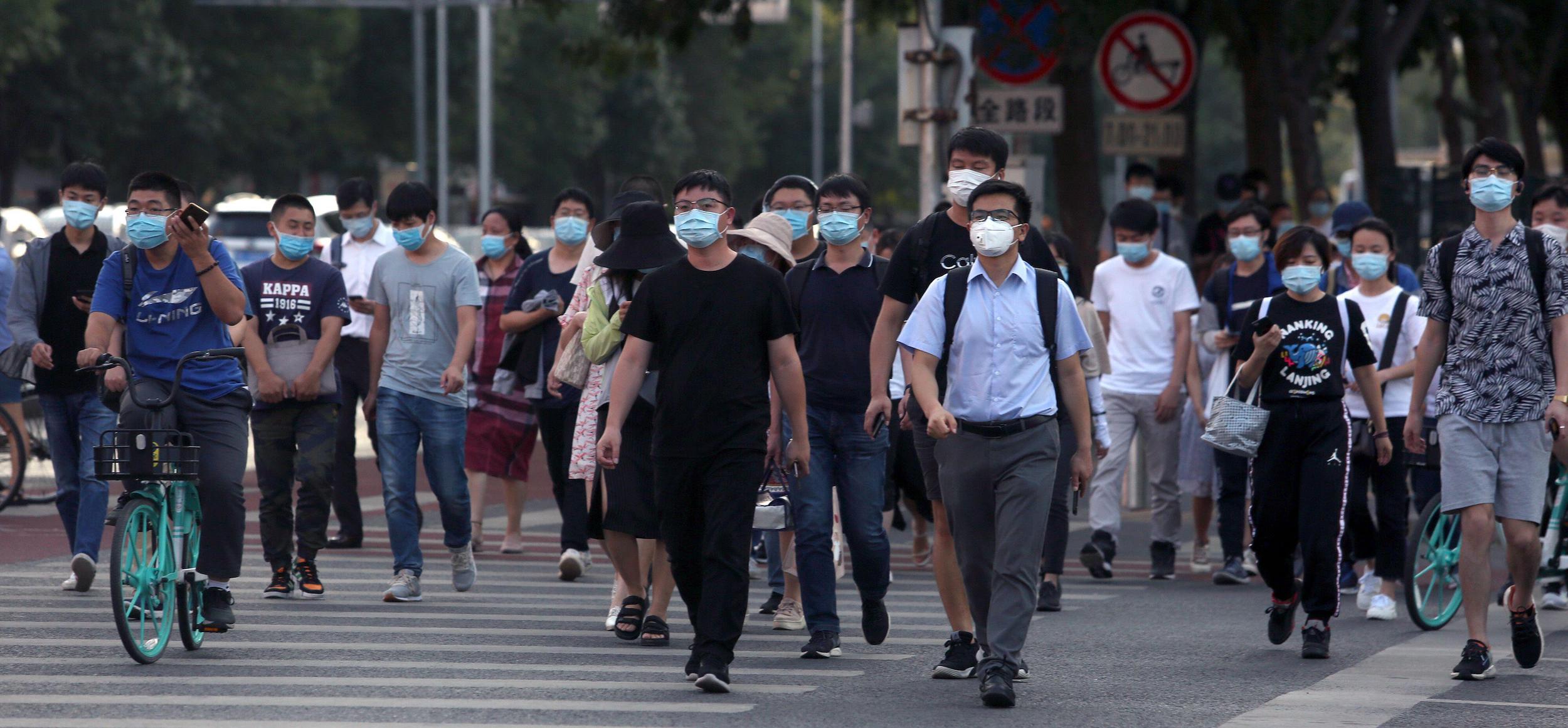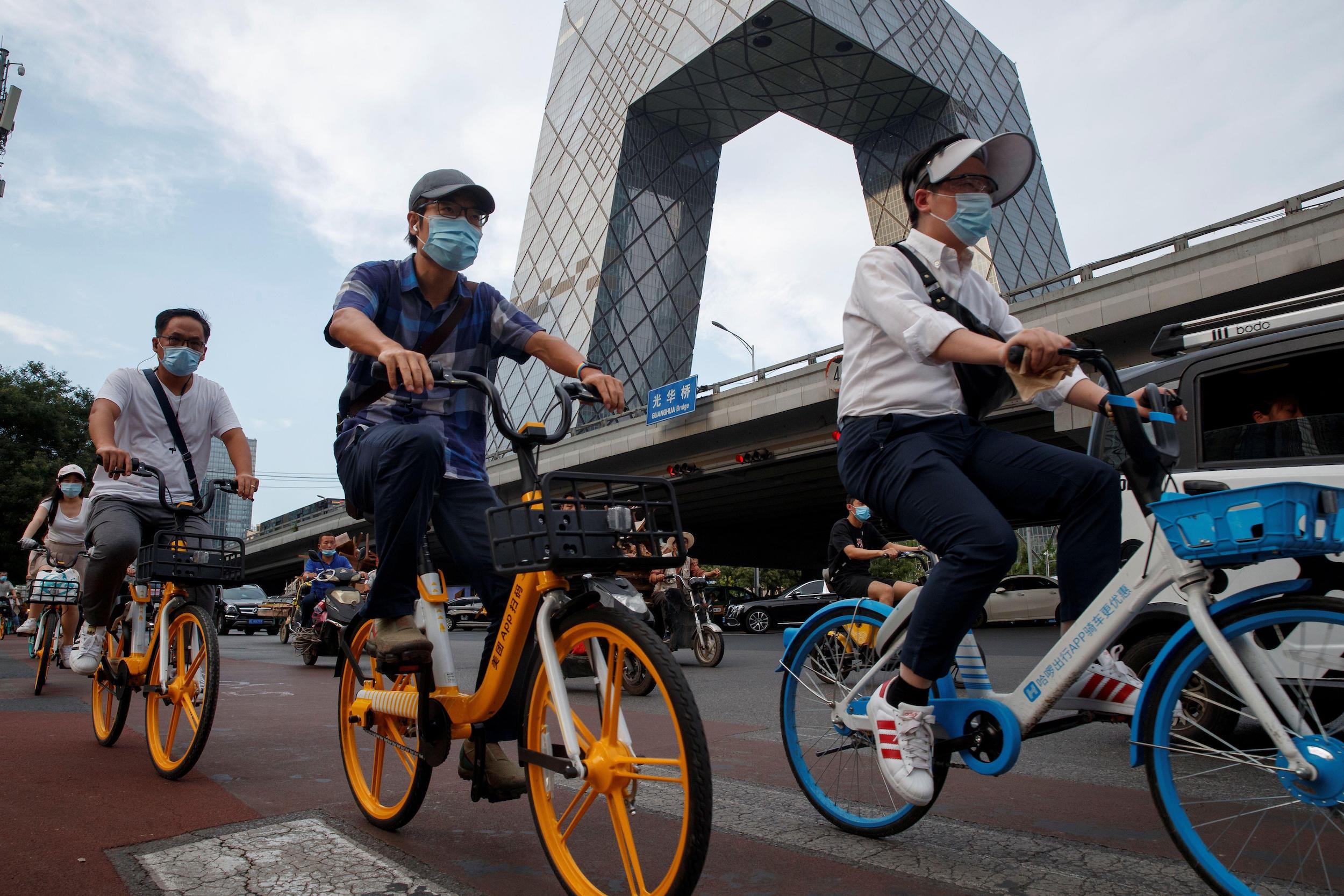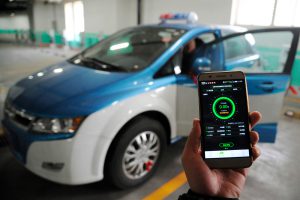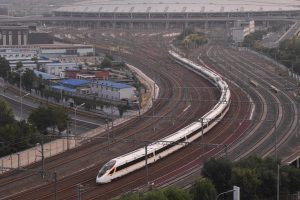The coronavirus is generally under control, but its shadow still hangs over the daily life and transport choices of China’s city dwellers.
People seem to be opting for private over communal modes of transport: passenger numbers on public transport have picked up but remain lower than before the outbreak. Meanwhile, journeys on shared bikes have recovered and more car journeys are being made than pre-Covid-19.
This is a worry as China’s urban pollution increasingly comes not just from coal burning, but from a complex mix of coal smoke, vehicle emissions and secondary pollutants. In 2018, “mobile pollution sources” accounted for more pollution than industry in Beijing, and were the main source of fine particle (PM2.5) pollution, accounting for 45% of local emissions, according to the municipal environmental authorities.
The moment for personal transport
As the pandemic eased off, urban transportation got back up to speed – but it still isn’t where it was.
Few people are commuting by subway on workdays. Late May saw subway passenger numbers only recover to 60-80% of December’s levels, according to figures gathered from 10 first- and second-tier cities by the National Business Daily. On 28 May, for example, Beijing and Guangzhou had reached 61% and 67% of December’s numbers respectively, with Shanghai at 78%.
Meanwhile, indexes of rush hour congestion generally rose. By 28 May, Beijing’s congestion index was 23% up on December’s levels, according to the survey. Shanghai and Guangzhou saw smaller increases, of 20% and 11%. Richard Liu, East Asia director for the Institute for Transportation and Development Policy, an international NGO, attributes those increases to more cars being on the roads.
Figures from bike-sharing firm Hellobike, which boast of having a 50% market share, show that rental figures had fully recovered in May, with large growth in user numbers. Shared bikes are also now being ridden longer distances. As the outbreak stabilised in China, Hellobike has seen a significant increase in the proportion of journeys of over 3km. This was most apparent in Wuhan, where three times as many longer journeys were made than previously. Richard Liu told China Dialogue that shared bike operators saw average journey lengths of 1km prior to the outbreak, but now often see trips of 3-5 km – which was the previous average for shared electric bikes. Bike riders are more willing to make complete journeys where previously they only peddled to and from public transport.
That personal transportation is quickly becoming more popular while public transport makes a slow comeback is down to wariness about virus transmission.
Will this current trend turn into lasting behaviour change? Will traffic figures continue to grow? Experts suggest answers to these questions have to do with how demand changes. New ways of working may reduce the need to commute, while fear of a new outbreak will make people less inclined to travel for work or leisure.
“Car sales may increase in the near-term, as people look for safer transport options. I have one colleague who’s preparing to buy a car, after finding not having one difficult during the pandemic,” said Gong Huiming, senior project director for Energy Foundation China’s transport program. “But in the long term, deeper impacts of the coronavirus on people’s transportation behaviour will reduce demand for travel and so reduce car use.” He pointed to how meetings have changed. Previously, Chinese firms rarely used teleconferencing – Tencent only released a videoconferencing service last December, but within two months it had over 10 million active accounts a day. “The pandemic has got everyone used to video calls, so they might not always opt for face-to-face meetings,” Gong said.
Deng Han, senior transportation engineer with the ITDP, agrees. He says people have moved around less during the pandemic, with offline activity moving online. In the medium and long term, the greater efficiency of working online will make this a habit, reducing the need to travel. “We’ll see changes in transportation in line with changes in how we live.”

Rail transport bides its time
Alongside these changes, government-led building of transportation infrastructure and favourable new policies for electric cars will also affect the transportation mix.
According to Beijing’s overall plans for 2016 to 2035, the city is due to have around 1,000km of subway and elevated rail by the end of 2020, and no less than 2,500km by 2035. But as of the end of last year, it had less than 700km. Guangzhou’s subway plans would see the city have a 2,000km urban rail transport network by 2035, four times as long as today. In 2018, the Shenzhen Metro Group told the media the city would have 580km of rail by 2022, with 33 lines stretching 1,335km by 2035 – nearly five times the current length. There is still huge potential for subway expansion.
According to the Beijing News, 59 urban rail projects across 12 regions were approved by national or provincial level development and reform commissions in 2019, with investments totalling 970 billion yuan (US$140 billion). Work was due to start in 2020 on 30 of those, worth 400-500 billion yuan. In March, some media outlets described rail transport as part of “neo-infrastructure” – which really means digitalisation and smart technology, including data centres and 5G base stations. Despite a media review of government stimulus measures finding that rail did not qualify as neo-infrastructure, and experts agreeing that it’s not “new infrastructure” either, markets still took an extra interest. Industry bodies have even predicted that investment in rail could reach 1.2 trillion yuan this year, and 6 trillion yuan over the coming five years. That interest, on top of ambitious government plans for subways, may result in a bigger rail construction rush and faster changes in public transportation choices.
Electric vehicles get government backstop
Meanwhile, in the car sector, the shift from traditional fuels to electricity is being closely watched.
Last July, after reductions in subsidies, monthly sales of electric vehicles (EVs) saw the first year-on-year fall for two years, and 2019 became the first year in a decade to see a reduction in EV manufacturing. With the dual impact of the pandemic and plummeting oil prices, consumers have become less enthusiastic about EVs: sales fell year-on-year until June, and dropped 37.4% year-on-year during the first half of the year.
Faced with this decline, the government stepped in. On 31 March, Chinese premier Li Keqiang chaired a meeting of the State Council, at which subsidies and tax waivers for purchases of EVs were extended for two years – the subsidy had been due to expire at the end of this year. On 23 April, the Ministry of Finance and three other ministries published new policies on subsidies, calling for a steady reduction, of 10%, 20% and 30% on the previous year’s level, in 2020, 2021 and 2022. But the government also tightened range restrictions: vehicles are now eligible for subsidies only when they have a range of at least 300km, rather than the previous threshold of 250km.
Alongside subsidies, the government is also pushing ahead with EV infrastructure. On 14 April, the State Grid started construction of 78,000 new charging points, at a cost of 2.7 billion yuan. This will include 53,000 charging points in residential communities and 18,000 in public locations. These charging points, spread across 24 provinces, will ease recharging difficulties for EV owners. It has been estimated that this new infrastructure will drive 20 billion yuan in spending on EVs.
These policies saw year-on-year sales of EVs rise in July, for the first time this year.
Meanwhile, provincial-level governments have also been loosening restrictions on car purchases to encourage EV take-up. On 1 August, Beijing announced it would allow 20,000 carless households to purchase EVs; Shenzhen has relaxed criteria for private purchasers of EVs, with non-permanent residents (people with a residence permit but no household registration/hukou) now allowed to apply; and Shanghai will continue its existing policy of not restricting purchase of EVs and of halving the length of the registration process. According to Gong Huiming, the greater ease of purchasing an EV is a key motivator for many buyers.
The Innovation Centre for Energy and Transportation (iCET), a Beijing- and Los Angeles-based thinktank, thinks these financial and non-financial measures will increase EV demand – but that the industry still has many issues in urgent need of resolution. These include recharging access, battery safety and recycling, and an imbalance in development of passenger and commercial EVs. And in a written response to China Dialogue, an iCET expert said that “the pandemic means a shake-up for the industry, an opportunity to integrate superior resources, improve manufacturing efficiency and eliminate substandard firms.”
But the more profound impact of the pandemic on transportation may be on public attitudes.
People are finding slower forms of transport more important. Richard Liu told China Dialogue that during lockdowns many people became more reliant on walking and cycling. Major cities such as New York, London and Milan have converted roads to cycle lanes – changes which will be permanent. Chinese cities are also actively developing slower transport options. For example, the Beijing Municipal Institute of City Planning & Design is designing the second phase of a bicycle expressway. The first phase opened last May, linking the residential district of Huilongguan with the high-tech industrial zone of Shangdi.
Deng Han thinks the pandemic has left people reluctant to make long leisure trips, and they now prefer to visit parks within a 10-15 minute walk. It is time, according to him, to advocate for the “15-minute city”, where services including leisure, exercise, shopping, healthcare and banking are all available within a 15-minute walk or cycle. “Moving in that direction would also help reduce car use,” he said.









